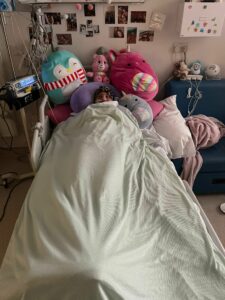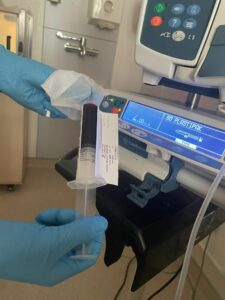A student from Liverpool has credited the transplant of blood taken from a Spanish baby’s placenta and umbilical cord with saving her life after treatment at Royal Manchester Children’s Hospital.
Lyra Cassell, 20, was 16 years-old when a friend noticed a lump on her body. She called her GP and was told it was a suspected hernia.
“Not long after I was told the lump was a hernia, I was out walking when I felt another lump, this time on my neck.” Explained Lyra.
“I went back to my GP who took my bloods and advised that I might be eating too much sugar and was close to being diabetic. It felt unlikely as I had always maintained a good diet and was very active, I have always been into my running.
“I was then chatting to a friend a few days later who pointed out a second lump on my neck. I had an appointment at Liverpool Royal Hospital and it felt like the first time someone took proper notice of it.
“The hospital’s consultant said it was definitely not a hernia and took a biopsy same day. I was told it was looking like cancer.”
Lyra was diagnosed with precursor T-cell lymphoblastic leukaemia, one of the rarest forms of blood cancer, and started chemotherapy at Alder Hey Children’s Hospital, five days a week for six weeks.

“After my chemo, I got my Measurable Residual Disease (MRD) results which showed that the chemo hadn’t killed any of the cancer. It had just stopped it from progressing and I was told we’d need to start looking at a transplant.”
Before a transplant could happen, the levels of cancer in Lyra’s body would need to be lowered, so a new round of chemo was started. A couple of months later, her MRD levels had come down so much that a stem transplant was deemed possible.
Lyra was transferred to Royal Manchester Children’s Hospital, one of the limited number of hospitals who can carry out the procedure, where it was recommended by Professor Robert Wynn that a cord blood transplant would be best.
Professor Rob Wynn, Consultant Paediatric Haematologist at Royal Manchester Children’s Hospital, explained the why a cord blood transplant was required:
“Most children with leukaemia are cured with drugs, known as chemotherapy, but with some children the drugs don’t kill all the leukaemia cells. Many of these children are cured with blood stem cell transplant. During transplant, the immune cells of the donor reject the leukaemia cells of the patient.
“I have promoted the use of cord blood as a donor cell source during my work at Royal Manchester Children’s Hospital over the last 30 years. We have noticed that the immune cells of a cord blood are particularly good at curing leukaemia.
“This means many of our children are alive after a cord blood transplant where another type of transplant might have failed. We continue to research why cord blood is better in this way, and how we might use it in different situations for children suffering from difficult-to-cure cancers.”

Lyra had total body irradiation twice a day for three days, which she described as ‘intense’:
“I had my transplant on 7th April 2022. The transplant itself was a tiny vial of blood, that was it! I still find it crazy how that small vial saved my life.
“The blood had been taken from a placenta and umbilical cord in Spain 12 years ago and frozen, it’s strange to think if that if a mother in a Spanish hospital didn’t decide to donate that blood in 2010, I wouldn’t have had a future.
“As it is, I am now studying Occupational Therapy at University and have done a half marathon since my transplant.
“The first four weeks following my transplant were tough, I was on a lot of heavy medicine and felt out of it. I couldn’t stomach food so had a feeding tube, the chemo and irradiation had damaged my nerves which, combined with being sedentary for so long, meant I could barely walk.
“It felt like everybody was getting on and I was staying still. Even when I was discharged I had to semi-isolate for six months, I saw some friends now and again but couldn’t risk any more than that due to the chances of infection. Recovery was a lonely place.
“I did manage to go back to school for year 13, but it was a struggle and I didn’t realise how tired and chronically fatigued I would be. But my friends were great, especially my best friend, Liv. She would leave class early with me and help me with the stairs and pretty much was my support.
“It was weird seeing everyone again and so much had changed but everyone was so lovely and supportive of me coming back.
“I found socialising great at the start because I had been so limited to it, but I also found I really didn’t have anything to talk about and being involved in conversation, even just listening, made me feel socially drained quite easily.
“Although so much had happened to me, nothing ‘teen interesting’ had and I didn’t want cancer to be the constant topic of conversation. I found that my friends didn’t want to ask too much either which was a really nice change to be seen and talked to as me again and not as a cancer patient.
“I found it hard sometimes to listen to what everyone had been up to and experiencing while I had been fighting for my life. I wouldn’t call it jealousy, but I did envy that sense of normality everyone else had that I never got to experience.
“I also really didn’t want to be labelled as the ‘cancer kid’ but it was hard to not be that when I looked so thin, my walking was visibly ‘not normal’ due to chemo causing nerve damage, wearing a wig and I often left school early due to fatigue.
“My mum says she is very proud of how I powered through school and A-levels, I can look back now and feel proud of it.

“My experience has informed my future as having gone through the physio and occupational therapy at Royal Manchester Children’s Hospital, I’ve been inspired to pursue it as a career.
“I liked that occupational therapists are the next step to home, the patients are on the path to recovery and the therapist is the one to help them cross the finish line to some sort of normality. I liked that the therapists look at the patient as a person, seeing past their medical diagnoses and really seeing them for them.
“I think from my experience of being labelled as a cancer patient, I liked the idea of giving someone their identity back even if it was only a small part of getting them back to something that made them, them.
“I’m also keen to continue to raise awareness of organ, blood and stem cell donation. My diagnosis sparked many friends and family to sign up and donors, one of my best friends’ uncles added himself to the donation list and within months was called up to donate his stem cells.
“It gives me peace of mind to know that my diagnosis has also helped other people.”
Cord blood can be donated to the UK’s public cord bank at several maternity units in England. For more information on how to donate, visit www.nhsbt.nhs.uk
To register as a blood donor, visit: www.blood.co.uk